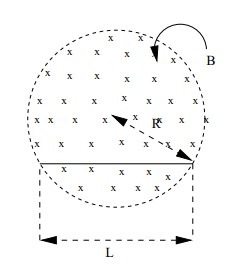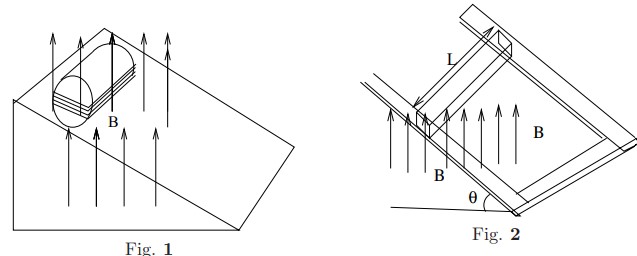Electrodynamics March 26, 2019
Tutorial-IV
- A uniform magnetic field $\vec{B}$ fills a cylindrical volume of radius $R$ and a metal rod of length $L$ is placed in it as shown in the figure.If the magnitude $B$ is changing at the rate $\frac{dB}{dt}$ show that the emf that is produced by the changing magnetic field and that acts between the ends of the rod is given by $${\cal E} = \frac{dB}{dt}\frac{L}{2}\sqrt{R^2-\frac{L^2}{2}}$$

- Two identical coils each having radius $R$ and $n$- turns are kept parallel and with a distance $d$ between the two.
- Find an expression for the magnetic field at a point on the common axis of the coils and at a distance $x$ from the mid-point between the coils.
- Show that if the separation of the coils is equal to $R$, the first and the second derivatives of $B$ w.r.t. $x$ vanish at the mid point. This produces nearly constant magnetic field near the mid point, WHY?
- For $R=5.0$cm, $I=50$amp,and 300 turn coils, plot the magnetic field as a function of $x$ in the range $x=-5$cm to $x=5$cm.
- A wooden cylinder of mass $m=0.5$kg, radius $R=3$cm, length $\ell=10$cm, is placed on an inclined plane. It has 10 turns of wire wrapped around it longitudinally so that the plane of the wire contains the axis of the cylinder and is parallel to the inclined plane, see . Assuming no friction, what is the current that will prevent the cylinder from rolling down the inclined plane in presence of a uniform magnetic field of 0.5T?. Describe what happens if the block is a rectangular instead of a cylindrical one? What will be the current that will prevent the block from moving down the plane?

- A square wire of length $L$, mass $m$, and resistance $R$ slides without friction down parallel rails of negligible resistance, as in \Figref{em-fig-015}. The rails are connected to each other at the bottom by a resistanceless rail parallel to the wire so that the wire and rails form a closed rectangular conducting loop. The plane of the rails makes an angle $\theta$ with the horizontal, and a uniform vertical magnetic field $\vec{B}$ exists in the region.
- Show that the wire acquires a steady state velocity of magnitude $$v= \frac{mgR\sin\theta}{B^2 L^2\cos^2\theta}$$
- Show that the above result is consistent with conservation of energy.
- What changes will be necessary in the above results, if the direction of magnetic field is reversed?
- A cylindrical shell of radius $R$, height $h$, and carrying a uniform surface charge density $\sigma$, rotates about its own axis with angular velocity $\omega$. Compute the magnetic field produced by the cylinder at a point on the axis
Exclude node summary :
n
Exclude node links:
0
4727:Diamond Point
0






 ||Message]
||Message]
